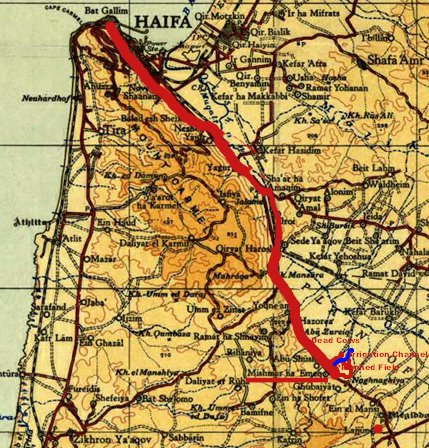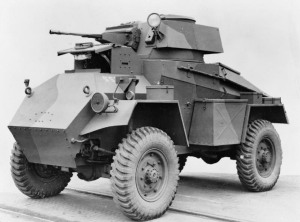Pages in Section 13

Battle for the Roads 2 - Mishmar ha Emek
ii. Massacres at refinery and Balad al Sheikh
iii. Battle for Jerusalem 1
iv. Ben Yehuda Street bombed
v. Jewish Agency bombed
vi. 1948 Views of a Traffic Policeman
vii. Battle for the Roads 1 - Jerusalem
viii. Battle for the Roads 2 - Mishmar ha Emek
ix. Battle for the Roads 3- Deir Yassin
x. Haddassa Hospital Convoy
xi. Battle of the Roads 4- Gush Etzion
Until April 1948 the battle of the Roads between Arabs and Jews was conducted by rifles, hand grenades, road mines and stones. All that changed when two units of the ALA* (Arab Liberation Army,) using weaponry more akin to the that of WW2 than anything used by the Arab Holy Army,* crossed the border from Lebanon and attacked a kibbutz in the sector of Palestine allocated to the Jews. Not that the rank and file Palestine Policeman knew the ALA had entered Palestine. They assumed the attackers were local members of the Arab Holy Army.
 The kibbutz attacked on 4th April was Mishmar ha Emek, not only important for its position on the A4,( Haifa to Jenin road) close to the Lajun crossroads, but also of sentimental value to the Palmach*, whose founder members had trained there under British sponsorship during 1942's Hundred Days of Terror. In 1948 it was still the Palmach's chief training school so that crack Haganah unit rushed to the rescue, complete with the sophisticated armoury they had been accumulating for use in a war certain to break out once the British had left.
The kibbutz attacked on 4th April was Mishmar ha Emek, not only important for its position on the A4,( Haifa to Jenin road) close to the Lajun crossroads, but also of sentimental value to the Palmach*, whose founder members had trained there under British sponsorship during 1942's Hundred Days of Terror. In 1948 it was still the Palmach's chief training school so that crack Haganah unit rushed to the rescue, complete with the sophisticated armoury they had been accumulating for use in a war certain to break out once the British had left.
The British army brokered a 24 hour truce the day after the battle commenced, during which time kibbutz children and their mothers left. Four of the twelve mine craters blocking the Haifa to Jenin highway were filled in to enable the evacuation. Once it was complete, the Jews refused to extend the armistice and battle recommenced.
 The continued fighting was of great concern to the upper echelons of the police in charge of the imminent evacuation of all British police personnel from the Jenin and the Galilee regions. They sent a CID Inspector, originally from Jerusalem but finishing off his service as a member of the Rear Party, in a Morris Recce car to patrol the road to Jenin as far as the crossroads.
The continued fighting was of great concern to the upper echelons of the police in charge of the imminent evacuation of all British police personnel from the Jenin and the Galilee regions. They sent a CID Inspector, originally from Jerusalem but finishing off his service as a member of the Rear Party, in a Morris Recce car to patrol the road to Jenin as far as the crossroads.
Sergeant Eric Howard, commander of armoured car M604 driven by B/C Bell, received orders, via B/C Jimmy James who was on wireless Control that day, to escort the Inspector.
At this stage,the Control unit, along with a skeleton staff, was still based at the Khayet House on Kingsway although the rest of Haifa HQ had already moved north to the Trades School by the airport. Jimmy James kept in contact with the reconnaissance party as far as Jalami Police Station on the edge of Haifa District but from there on the recce party were out of his wireless range. An hour or so later Jimmy James became anxious over the length of time the reconnaissance party was taking to return from Lajun.
By chance, over at the new HQ in the Trades School, Sergeant Paddy Sayers, who was in charge of HOP, was playing with a new wireless, one the Rear Party would use when Control finally left Khayet House. To his surprise, he heard frantic cries for help from the Reconnaissance Party.
Paddy Sayers had not been informed that the ALA had crossed the border and it was they, rather than the poorly armed Palestinian irregulars, who had attacked Mishmar ha Emek, so,when Sergeant Howard reported that their vehicles were under continuous shell fire while stuck in ditches outside Mishmar ha Emek, - he only believed it when he heard the sound of exploding shells for himself. He immediately gave Jimmy James the location and told him to send three HOP cars to the rescue.
B/C Gerald (Dodger) Green was the driver of one HOP car with B/C Jeff Haworth as the commander and B/C Bill Hughes as the wireless operator. Gerald immediately sped off on Haifa's Lower Road at 60 miles an hour, lights on, horn blaring. In East Haifa he found his way blocked by a huge American open-top, in the back seat of which lolled an excessively overweight business man in dark glasses attempting to light a cigar. The car's chauffeur had obviously been given strict orders not to move until this important operation had been completed. Gerald was in no mood to let anything stand between him and the rescue of his comrades in distress. So using fairground tactics he had learned as a youngster, he turned his wheel sharply and shunted the offending car off the road.
At an average speed of almost seventy miles per hour, it took three five ton armoured cars less than ten minutes from receiving the message to reach Mishmar ha Emek but, even before they reached the kibbutz, they heard the sound of gun fire. The first visual signs of trouble were four roughly filled-in craters in the road. Once they had bounced over those, they saw on their right hand side the shrapnel and bullet damaged buildings of Mishmar ha Emek. Beyond these were the still smoking ruins of a hill-top Arab village. Pasture land to the left of the road displayed dead cattle lying on their backs, legs pointing skywards. Just before a second set of craters blocked the road, the rescue team located the dirt track passing between a copse and a ploughed field that Jimmy James had told them to look out for. Halfway down the track they saw Sergeant Howard's armoured car sunk to its axles in mud where one side of the track had collapsed. At the end of the track the recce car lay nose down in an irrigation channel.
Sergeant Howard asked the commanders two of the HOP cars, including the one driven by Gerald Green to return to the main road to deter any Arabs from advancing over the ridge. There was third set of craters blocking the road at the foot of the steep ridge just beyond the kibbutz that would slow the Arabs down if they tried to get vehicles across. Earth banks on each side of the craters meant the craters couldn't be by-passed. It was those craters, the sergeant said, that had caused the present predicament but on the other hand had probably saved the reconnaissance party from driving into an Arab ambush. M604 and the recce car had actually succeeded in crossing the third set of craters by using the sad trays screwed the side of M604. While Bell, his driver was screwing the trays back, two Arabs in khaki had man-handled an artillery gun over the ridge. Sergeant Howard had swivelled his gun round, and shouted a warning. The men had retreated behind the ridge but within seconds bullets had struck his car, and two mortar bombs had exploded in front and beside him. The drivers were unable to unscrew the sand trays under fire so with the recce car leading the way they had retreated round the edge of the ploughed field towards the dirt track.
Having explained the situation Sergeant Howard asked the driver of the third HOP car to tow M604 from the ditch and then go down to the recce car in the irrigation channel. The HOP car took up position on the other side of the track, but before it could haul M604 to terra firma, its side of the track collapsed, leaving it also completely immobile. The second HOP car came down to assess the situation while a fresh outburst of shelling from over the ridge, aimed at M604 was answered by the commander in charge of Gerald Green's car and the shelling restarted in earnest. Sergeant Howard wirelessed Paddy Sayers who agreed that it would be idiotic to risk the two mobile trucks in further rescue attempts and said he would ask the army to send a proper recovery vehicle. Meanwhile they were to stay in position guarding the trucks The shelling eased up when the sun set. It seemed a miracle no cars had yet received a direct hit.. However, the crews were conscious that five arrmoured cars complete with wirelesses, guns and ammunition would be a welcome prize for Arab or Jewish combatants so one side or the other might take advantage of the dark to creep up in force.
Despite the darkness, Gerald Green, still guarding the main road, made out human shapes, and many of them, moving stealthily on the hills behind the kibbutz. He reported to the other cars and all crews tensed up ready for an imminent attack. They agreed that if they looked to be overwhelmed, while the commanders supplied cover fire, the others would destroy the wirelesses and trapped vehicles and they would all squash into the two mobile vehicles and make a dash for Haifa, but there was no more firing.
At just after 1 am Gerald Green reported the arrival of a Sherman tank recovery vehicle. It had been hit by a shell on its journey but was still intact. In ten minutes, men from the 3rd Hussars had rescued the trapped cars and all returned safely to Haifa leaving the Jews and Arabs to fight it out amongst themselves.
The defeat of the ALA in their first battle marked a turning point in Palestine's Civil War in which both British Army and Palestine Police played almost incidental roles.